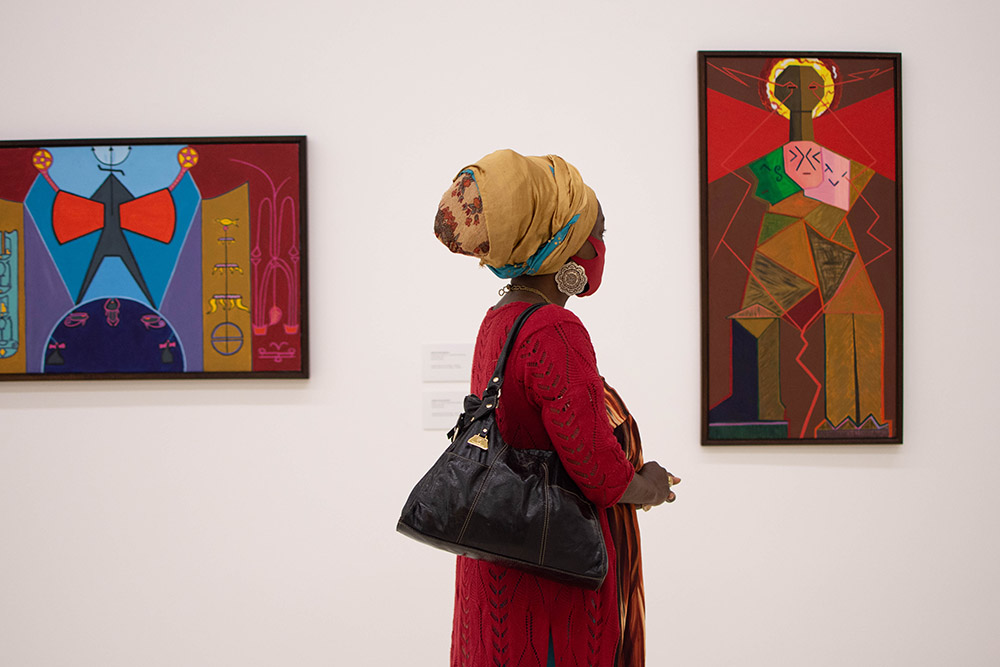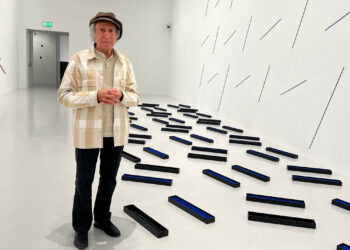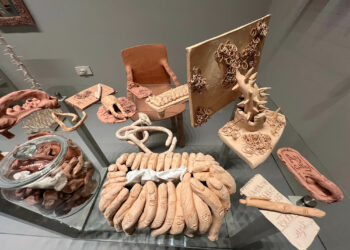Instituto Inhotim hosts major exhibition highlighting African, Afro-Brazilian and Afro-diasporic artist in two year exhibition programme

‘Abdias Nascimento, Tunga and the Black Art Museum’ at Galeria Mata, Inhotim. © Ana Luiza Albuquerque
Abdias Nascimento is one of the leading agents of the Brazilian arts in the 20th century. He was an artist, collector, cultural manager, art critic, visual artist, playwright, professor, writer, activist and politician. He also made important contributions to the country, especially the arts from African, Afro-Brazilian and Afro-diasporic origins. One of his projects, the Museu de Arte Negra (MAN, Black Art Museum), made it possible to discuss the contributions of the so-called “black arts” to the historical and cultural formation of the country, being a significant milestone in its preservation and dissemination.
MAN was created in 1950, during the 1st Congress of the Brazilian Negro, an event organised by the Teatro Experimental do Negro (TEN) – the first theatre company in the country exclusively with black actors, and which was also founded and directed by Nascimento. MAN’s project was daring for the time, since, in addition to inaugurating the conceptual debate of “black arts” into the museum field, it also challenged the hegemonic artistic circuit based on perspectives favouring Euro-Brazilian productions, revolving around the white economic elites from southeastern regions of the country.

‘Abdias Nascimento, Tunga and the Black Art Museum’ at Galeria Mata, Inhotim. © Ícaro Moreno
The so-called “Black Art” was the term used at the time to refer to the creations of African, Afro-Brazilian, Afro-diasporic and/or influenced by them, but which, in recent years, has been re-discussed by researchers, gaining new insights. conceptual and naming possibilities. Questions like: What is black art? A production created only by so-called black people? Only in territories recognised as black? If there is black art, is there white, yellow, brown, etc.? Would it be possible to define an artistic production by the race attributed to its creators? Questions promote a deeper understanding of the term beyond its continuous reproduction.
One criticism can be made to the fact that this term was based on racialist, evolutionary and simplistic colonial studies, which relegated African societies and Afro-descendants to positions of inferiority, curiosity and exoticism. An example of how the term was used at the time can be seen in the writings of Ladislas Segy, a Hungarian art dealer who owned a “gallery specialising in African arts” in New York City, and who also circulated through the São Paulo art scene in the 1950s, organising lectures and promoting sales. Segy’s discourse generally presents the African productions as dark, terrifying, “magical,” rustic and often indecipherable to their creators, framing them in reductionist notions such as “primitive art” and “naive art”.

‘Abdias Nascimento, Tunga and the Black Art Museum’ at Galeria Mata, Inhotim. © Ícaro Moreno
Abdias Nascimento had a daring plan to re-write the arts, something little understood by his contemporaries, as he was not interested in reinforcing the colonial idea of artistic primitivism or simplicity of the African societies and their descendants, but rather the building of complex aesthetic ideas based on pan-Africanist theories, thus re-founding the arts from “the Africans and their creations,” as he claims in a text for the Galeria de Arte Moderna (GAM) magazine, published in 1968.
Unfortunately, the difficulties in obtaining support made it impossible for the MAN to be physically implemented – despite its expressive collection, it managed to hold few exhibitions, and is still to this day, after more than 70 years, in pursuit of a headquarters of its own. One of the recent partnerships for exhibiting the museum’s collection was announced by Instituto Inhotim, one of the few open-air contemporary art museums in the world, located in the town of Brumadinho, in the state of Minas Gerais, Brazil.

‘Abdias Nascimento, Tunga and the Black Art Museum’ at Galeria Mata, Inhotim. © Ícaro Moreno
Scheduled to last two years, the action will have four distinct acts, the first one, from December 2021 to April 2022, under the title ‘First Act: Abdias Nascimento, Tunga and the Black Art Museum’, occupying the Mata Gallery, of the Instituto Inhotim. At the moment, the institution is preparing the second act, scheduled to open in May 2022, which will present MAN developments in dialogue with the contemporary.
Jointly curated by Douglas Freitas, Deri Andrade, Elisa Larkin Nascimento and Julio Menezes – the first two are curators at Inhotim, and the last two are members of the Instituto de Pesquisas e Estudos Afro-Brasileiros (IPEAFRO, Institute for Afro-Brazilian Research and Studies), an organization founded in 1981 to further Abdias Nascimento’s legacy – the exhibition brings together pieces from the MAN collection, as well as works by Abdias Nascimento and Tunga, a Euro-Brazilian artist, who was close friends with Abdias. The show is supported by Emicida, singer and activist, and Erica Malunguinho, congresswoman, cultural manager and arts researcher.
According to the curators, they want to showcase Tunga and Abdias’ friendship by having the Euro-Brazilian artist welcome Abdias and MAN in the spaces of Inhotim. In addition to being a friend of the artist, Tunga was one of the first artists in the collection.

‘Abdias Nascimento, Tunga and the Black Art Museum’ at Galeria Mata, Inhotim. © Ícaro Moreno
The exhibition brings documents and themes that bring them together, among them the study of geometry, one of the themes that guided the visual arts of the 60s and 70s, that was deepened by Abdias through reference to the Nigerian and Afro-Yoruba cosmologies of Brazilians.
In the center of the room are exhibited pieces by artists from the MAN collection, in productions by artists such as the Trinidadian and Tobagonian Leroy Clarke, the Angolan Filipe Salvador, the African-American Romaré Bearden, and the Brazilians Inácio Rodrigues, Augusto Rodrigues, Octávio Araújo, Loio-Pérsio, Sebastião Januário, among others. The MAN and its collection afford us multiple readings regarding the discussion of the arts in Brazil and worldwide – for instance, the fact that it promotes unique interactions that haven’t yet been fully explored in the art system. Despite his impressive trajectory, Abdias Nascimento isn’t as widely researched by the art departments of Brazilian universities, which poses an obstacle for a deeper dive into the MAN collection. The maintenance of racist structures meant that projects like this one had little, if any, insertion and permanence in the artistic milieu. It is now Inhotim’s mission to take on this challenge and extend it over the next few years.
Luciara Ribeiro, born in Xique-xique, Bahia, in 1989, works as an educator, curator, and researcher, primarily on topics such as the decolonisation of education and the arts and the study of non-Western art, with a particular focus on African, Afro-Brazilian, and Amerindian art.
For more information, please visit Inhotim.



